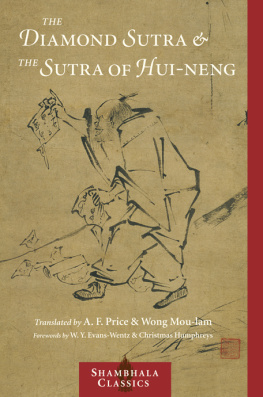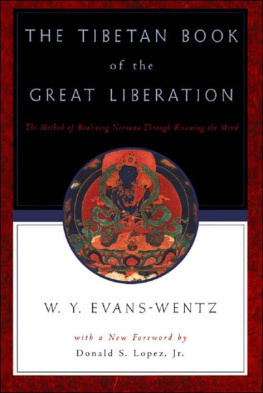Tibetan Yoga and its Secret Doctrines
This exceptional work of scholarship, which is so accessible to the interested general reader, is the work of the eminent scholar and believer who brought to the world The Tibetan Book of the Dead and an equally important work entitled Tibets Great Yogi Milarepa. This book, perhaps the most valuable in the trilogy, gives the very deeds of some of the principal yogas and meditations which many of the most illustrious Tibetan and Indian philosophers, including Tulopa, Naropa, Marpa, and Milerepa, employed in attaining Right Knowledge.
W.Y. Evans-Wentz helped develop western understanding of Oriental religions, especially Tibetan Buddhism. His consuming vocation was to improve the understanding between the East and West.
Tibetan Yoga and its Secret Doctrines
Attaining Right Knowledge
W.Y. Evans-Wentz
First published in 2003 by
Kegan Paul International
This edition first published in 2011 by
Routledge
2 Park Square, Milton Park, Abingdon, Oxon, OX14 4RN
Simultaneously published in the USA and Canada
by Routledge
711 Third Avenue, New York, NY 10017
Routledge is an imprint of the Taylor & Francis Group, an informa business
Kegan Paul, 2003
All rights reserved. No part of this book may be reprinted or reproduced or utilised in any form or by any electronic, mechanical, or other means, now known or hereafter invented, including photocopying and recording, or in any information storage or retrieval system, without permission in writing from the publishers.
British Library Cataloguing in Publication
Data A catalogue record for this book is available from the British Library
ISBN 10: 0-7103-0838-8 (hbk)
ISBN 13: 978-0-7103-0838-2 (hbk)
Publishers Note
The publisher has gone to great lengths to ensure the quality of this reprint but points out that some imperfections in the original copies may be apparent. The publisher has made every effort to contact original copyright holders and would welcome correspondence from those they have been unable to trace.
MODERN GURUS
Described on pages xviii-xix
THIS BOOK
OF
SEVEN BOOKS OF WISDOM
OF THE YOGA PATH DIRECT
I DEDICATE
TO THEM THAT SHALL SUCCEED ME
IN THE QUEST ON EARTH
WISDOM-TEACHINGS AND GOOD-WISHES OF THE DI-BUDDHA SAMANTA-BHADRA
The Foundation of all is uncreated, uncompounded, independent, beyond mental concept and verbal definition. Neither the term Sangsra nor the term Nirva can be applied to It. To realize It is to attain Buddhahood. Not to realize It is to wander in the Sangsra.
Not knowing the Foundation, beings aforetime erred. They were overwhelmed by the darkness of unconsciousness, whence sprang ignorance and error. Immersed in error and obscured by ignorance, the knower became bewildered and afraid. Then arose the concepts I and Others, together with hatred. When these had grown strong, there was born an unbroken current of sangsric evolution. Then the five poisons of the obscuring passions, lust, anger, selfishness, delusion, and jealousy, flourished, and there was produced an interminable chain of evil karma.
The root-source of error among sentient beings is thus unconscious ignorance. And, in virtue of the power of the Good-Wishes of Me, the di-Buddha, may each of them realize the radiant, immaculate mind, innate in every living thing.
From The Good-Wishes of the All-Good Buddha Samanta-Bhadra
(Lma Kazi Dawa-Samdups Translation).
PREFACE
A S in The Tibetan Book of the Dead and in Tibets Great Yog Milarepa so in this book, the third in a threefold series, my aim has been to place on record not only a catena of carefully made translations of texts which are as yet almost unknown in Occidental countries, but also a body of orally transmitted traditions and teachings relating to the texts, which I received from the late Lma Kazi Dawa-Samdup, who was my Tibetan guru.
The present work thus contains much that is new to Western thought, and much that, apart from its value for philosophy and religion, is interesting anthropologically. It should prove to be of the same quality and public appeal as the two volumes of the series which have already been published. Perhaps it may be found to be the most valuable member of the trilogy, inasmuch as it gives the very texts of some of the principal yogas and meditations which many of the most illustrious Tibetan and Indian philosophers, including Tilopa, Naropa, Marpa, and Milarepa, employed in attaining Right Knowledge.
This volume is meant at once for the exact scholar and for the general reader. The former will note that the original textual sources, which are sevenfold, are authentic, and that nothing has been incorporated into the texts or presented in the introductions and annotations which has not doctrinal sanction.
The seven chief texts upon which the seven Books, or parts, comprising this volume are based contain teachings and matter dating a long way beyond the time to which the actual manuscripts and block-prints can be referred. A full discussion of this question is contained in the special introductions to the seven Books. The shortened titles of these seven texts, rendered into English, are as follows:
(1) Gampopds Supreme Path, called The Precious Rosary, consisting of twenty-eight categories of yogic precepts for the guidance of the disciple;
(2) The Epitome of the Great Symbol, a treatise on the practical yogic method of realizing Nirva;
(3) The Epitome of the Six Doctrines, which are the Psychic-Heat, the Illusory Body, the Dream-State, the Clear Light, the After-Death State, and the Transference of the Consciousness;
(4) The Transference of the Consciousness, a yogic treatise complementary to the last of the Six Doctrines;
(5) The Method of Eradicating the Lower Self a treatise on the Yoga of Non-Ego;
(6) The Five-Fold Wisdom Attribute of the Long H, a treatise on the Yoga of the Five Wisdoms;
(7) The Essence of the Transcendental Wisdom, a short Sutra belonging to the Praj-Pramit of the Tibetan canon.
For the benefit of the general reader, I have prefixed to the treatise, in the form of a General Introduction, a brief account of Buddhism, so presented as to contrast with our European conceptions of religion and philosophy, and, to some extent, science. Similarly, in my exposition of the Yoga Philosophy, upon which the treatise as a whole is based, I have made use of teachings which have come to me from trustworthy teachers during the course of careful inquiry and research extending over a period of more than fifteen years, spent mostly in the Orient.
In a realm so filled with difficulties for the European mind as this book attempts to explore, it is not to be expected that I have always escaped error. In any event, I trust that readers and critics of this volume will recognize in it, despite any such shortcomings as it may perhaps exhibit, a sincere effort to help, in some small degree, to bring about amongst the peoples of the Western World a better understanding of some of the master minds of Tibet and of India.










